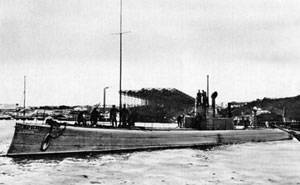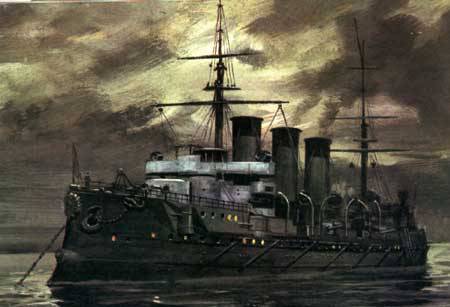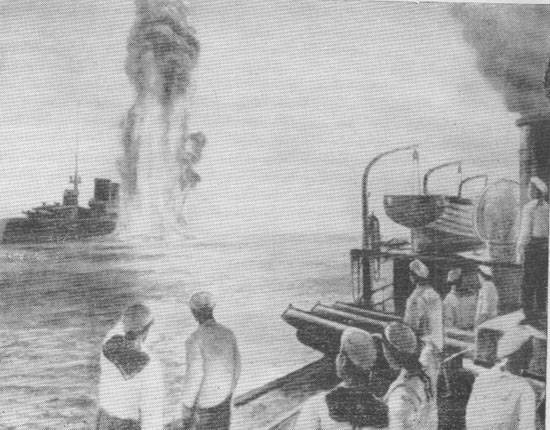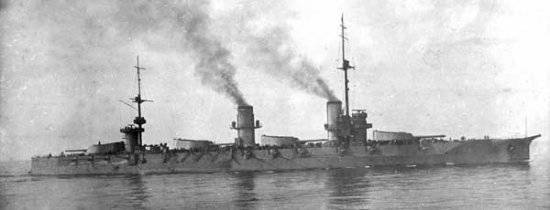Black Sea Fleet in the First World War. Part of 4
 1916 was a victory for the Black Sea fleet: he confidently controlled the sea, practically blocked the Bosphorus by minefields, carried out landing operations, supported the Caucasian and Romanian fronts. Developed rapidly aviation fleet, in fact, prototypes of aircraft carrier-strike groups were formed, where the actions of heavy battleships combined with the actions of air transport. The submarine and destroyer forces of the fleet were growing, the Bosphorus operation was being actively prepared, which would be a wonderful end to the small victories of the Black Sea Fleet from the beginning of the war.
1916 was a victory for the Black Sea fleet: he confidently controlled the sea, practically blocked the Bosphorus by minefields, carried out landing operations, supported the Caucasian and Romanian fronts. Developed rapidly aviation fleet, in fact, prototypes of aircraft carrier-strike groups were formed, where the actions of heavy battleships combined with the actions of air transport. The submarine and destroyer forces of the fleet were growing, the Bosphorus operation was being actively prepared, which would be a wonderful end to the small victories of the Black Sea Fleet from the beginning of the war. Even the tragic death of the battleship "Empress Maria" did not darken the picture. The Black Sea became the Russian Lake. The last brushstroke in the picture remained - Russian banner over Sofia.
But the February Revolution broke the victorious movement of the empire. The fighting began in the new year with the fact that the 5-9 of January to the Bosporus to intercept the "Geben" went 2-th brigade of battleships. During the campaign, 39 was destroyed by Turkish transport workers. Destroyers and submarines were active, so 27-30 on January, the Hasty and Daring destroyers from Anatolia destroyed 13 and captured 7 sailboats. The submarine "Kashalot" from 25 December 1916 of the year to 11 September 1917 of the year went to 8 campaigns, drowned and seized 25 ships. For all the time of hostilities, the fleet lost only 1 — well, the submarine “Walrus” (in May); in 917, it made an 4 march, destroying and capturing 14 sailboats.
February Revolution and the Black Sea Fleet
The February events in Petrograd, the emperor’s abdication (March 2) sharply undermined morale and discipline. The murders of officers in the Baltic Fleet, Admiral Nepenin, all this could not but affect the psychological state of the Black Sea region. In addition, revolutionary agitators from different parties arrived in the fleet, the most successful were the Bolsheviks, anarchists and Ukrainian national socialists.
The orders of the Provisional Government, which were destructive in their essence, brought even more confusion: political prisoners were released, the police and the Sevastopol gendarmerie were dissolved, the formation of the militia began, the Order No. 1 of the Petrograd Soviet, the Military and Maritime Minister was put into practice. This order introduced "democracy" in the army and navy, ruined the entire military system of the empire. In June, Sevastopol visited Kerensky, but his visit could not change the situation. The virus of destruction has penetrated the Black Sea Fleet.
There were cases of sabotage, the criminal element was revived, and robbery became more frequent in the previously peaceful Sevastopol. Crews did not obey the officers, and in June they disarmed the officers. By July 1917, the fleet was disorganized. The combat training was stopped, officers not acceptable to the crews, were driven out of the ships, drunkenness and speculative trade flourished. A.V. Kolchak left his post.
Ukrainian nationalism flourished rapidly, the Central Rada was created in Kiev, in the summer the Provisional Government placed under its control several provinces of Little Russia. But the appetites of the new gentlemen spread further; in the Crimea and the Black Sea Fleet, agitation of the Ukrainian "separatist" begins. In August-September, the fleet was an interesting picture: some ships were under the St. Andrew’s flags, some under the red ones, some under the black ones (anarchists) and 4-e under yellow-blue, Ukrainian ones. Of course, most of the sailors were far from politics, and raised these flags, so as not to fight.
Fleet actions in the summer and autumn 1917. limited to raids by destroyers who still troubled the Turkish coast. The last campaign was an attempt to intercept the German cruiser Breslau, a squadron comprising: the battleships Svobodnaya Rossiya (renamed in February from the Empress Catherine the Great), Volya (Alexander III), 2 Brigade of Battleships, 5 destroyers and air transport "Romania", went to sea from October 31 to November 5.
Death of the Black Sea Fleet
By the October events, the Black Sea Fleet had almost lost its combat capability, like the entire army. At the end of 1917 and the beginning of 1918, a bloody wave of officer killings swept through Sevastopol. Basically they killed those involved in the suppression of the uprising of the cruiser Ochakov (1905 year), but many uncomplicated people suffered. The Bolshevik government did not have the opportunity to continue the war and they signed the 3 in March of the Brest peace treaty. It included an item relating to the Black Sea Fleet. The fleet had to disarm and not leave its bases. But then Germany demanded to bring the warships and fleet infrastructure under its control, and its allies (including the Ukrainian government).

15 April 1918 of the Year Germany accused Russia of violating the 5 article of the Brest Treaty ("... Russia will either transfer its military ships to Russian ports and leave there until the conclusion of universal peace, or immediately disarm!") And began the invasion of Crimea. 19 April German-Ukrainian troops occupied Dzhankoy, 22-th Simferopol; the Red Navy tried to resist - groups of up to 2, 5 thousands entered the battle and were destroyed in the district of Alma and Belbek. On April 29, the Germans reached the suburbs of Sevastopol and began to install guns. The 29-30 of April, part of the ships (including the newest battleship 2, 12 destroyers and light cruiser) broke through, under enemy fire, from the harbor and left for Novorossiysk. The remaining (6 old battleships, all submarines, more than 20-T destroyers, partly damaged by crews), raised Ukrainian flags and were captured by the Germans, after them by the French, some of them received the White movement.
1 May the Germans entered the city, and 2-th "Goeben", this day can be considered the day of the final destruction of the fleet. Although all the ships were afloat, there was no will to turn them into a single combat mechanism. Their existence was supported only by the enthusiasm of individual groups of officers and sailors. 11 May Germans demand the return of ships from Novorossiysk to Sevastopol. June 9 resume offensive inland. The government decided to scuttle the ships, there was no strength to fight the Germans, but it was impossible to give them back. Part of the crews rebelled and, led by the battleship Volia, returned to Sevastopol.

18-June destroyer "Kerch" and "Lieutenant Shestakov" began towing the doomed ships Tsemess Bay, where ships torpedoed and sunk by opening Kingston (battleship "Free Russia", 6 destroyers, 2 destroyer, 6 transports, 1-but Tender) . The destroyer "Kerch", which carried out this sad mission of torpedoing, left in Tuapse and was flooded there, throwing out the signal: "I am dying, but I do not give up!".
The German occupation of Crimea caused damage to 3 billion gold rubles. "Allies" on the Entente, after the Germans left, looted the assets of the Black Sea Fleet with 5 billion in gold. In addition, they captured the best ships - the battleship "Alexander" ("Will"), the latest destroyers and took them to the ports of Turkey.
The last part of the tragedy of the Black Sea Fleet was the departure of the so-called. White Guard Fleet of Baron Wrangel in 1920. Totally gone before the 150 pennants, including the 3 old battleship, 3 cruisers, 10 destroyers, 4 submarines, 12 gunboats, etc.
Conclusion
Despite some shortcomings, the Black Sea Fleet displayed high naval art in the war. The fleet recovered after a heavy strike from Tsushima. During the war, the fleet used many new products:
- the use of specially created military units (brigades) to support the operations of the Caucasian Front and the protection of the transport flotilla;
- the use of landing craft and landing craft;
- in fact, the creation of carrier strike groups;
- widespread use of hydroaviation - reconnaissance, adjustment of ship fire, bombing of enemy infrastructure, anti-submarine activity;
- extensive use of the mine-carrying and submarine fleet, their interaction with the main forces of the fleet, and maritime aviation.
During the war, the Russian admirals, officers and sailors showed high skill and training. Only the Revolution did not allow to complete the Case. The Imperial Black Sea Fleet won the war, and perished undefeated. His resurrection will occur in the period of the Soviet Union. And many sailors and officers of the old fleet will take part in it.

Information